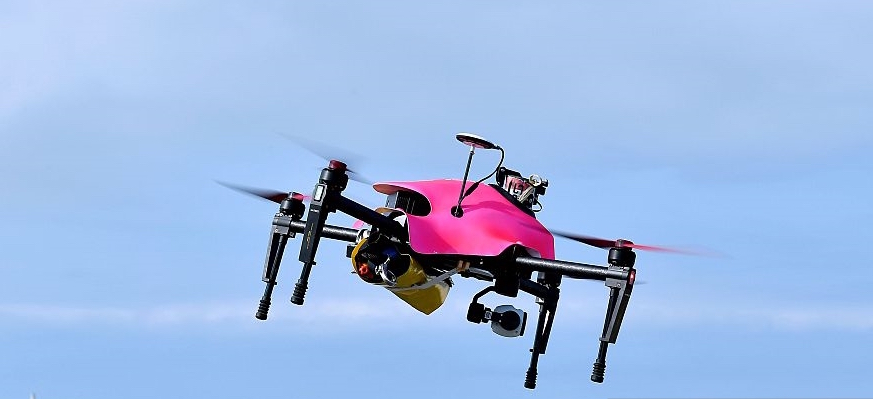Recently I have found out about a drone called HELPER (Human Environment and Life Protection Emergency Response) which is specially designed to detect people in the water. This summer it has been used for the first time at the Atlantic coast in France to improve the time the lifeguards need to rescue people from drowning. The drone is able to attend the person by throwing a self-inflating buoy a minute earlier than the professional lifeguards, which means a lot to someone who is in difficulty (Le Figaro, 2016). The drone used in France has been developed by Total, an oil and gas company, to assist in search and rescue, environmental protection and rig safety (The Engineer, 2016). It carries a thermal camera with which it can search for people at sea and assess the scale of leaks and spills. Actually
different equipments can be installed to let the drone serve for different purposes. The idea is not completely novel as in 2013 the RTS Labs in Iran together with Amin Rigi have already started to develop a drone that could be produced in large amounts to assist lifeguards throughout the world in their work. This drone is called the PARS Arial Rescue Robot (Popular Science, 2014).
Although, the commercial drone industry is still at the beginning of its lifecycle, they have in recent years gone through fast development (Drone Industry Insights, 2016). There are already a lot of technologies and products available and the HELPER and PARS are only one example of what a drone could do.
Multiple businesses have invested highly in this unmanned aerial vehicle (UAV) to achieve performances exceeding their competition. For example, Amazon, is developing Amazon Prime Air to create a new competitive advantage. With the use of drones, they are aiming at delivering their customer orders within 30 minutes. If you want to see what it currently looks like watch this video.
And like Amazon there are multiple other companies trying to create a competitive advantage through UAV such as Mercedes Benz with their Vision Van Electric Concept or Google with its Project Wing (FastCompany, 2016).
Of course the drone technology still has to undergo improvements and regulations have to made but it might soon be very common to see drones flying around to either save our lives or save our time.
References
Le Figaro, 2016. Sécurité des plages : un drone pour sauver des vies. [ONLINE] Available at: http://www.lefigaro.fr/actualite-france/2016/07/05/01016-20160705ARTFIG00344-securite-des-plages-un-drone-pour-sauver-des-vies.php. [Accessed 09 October 2016].
The Engineer, 2016. New multi-mission drone from Total | The Engineer. [ONLINE] Available at: https://www.theengineer.co.uk/new-multi-mission-drone-from-total/. [Accessed 09 October 2016].
Popular Science, 2014. Lifeguard Drone Ready For Mass Production [Video] | Popular Science. [ONLINE] Available at: http://www.popsci.com/article/technology/lifeguard-drone-ready-mass-production-video. [Accessed 09 October 2016].
Drone Industry Insights, 2016. Drone Investment Trends 2016 – Drone Industry Insights. [ONLINE] Available at: https://www.droneii.com/drone-investment-trends-2016. [Accessed 09 October 2016].
Fast Company, 2016. This is How Google’s Project Wing Drone Delivery Service Could Work | Fast Company | Business + Innovation. [ONLINE] Available at: https://www.fastcompany.com/3055961/fast-feed/this-is-how-googles-project-wing-drone-delivery-service-could-work. [Accessed 09 October 2016].


Hi Clémence, thank you for this interesting blog! It shows a promising application of the UAV for rescuing people from danger.
Unmanned aerial vehicle (UAV) is usually preferred to execute missions that are dull, dirty or dangerous for humans. Although initiated from military utilizations, it now spreads to commercial, scientific, agricultural fields. However, every coin has two sides. While lots of promising applications appeared, some issues have been aroused about the UAV. For instance, the UAV can threaten the security of the aircrafts. Imagine that a drone intrudes the airport accidently, how dangerous will it be? In fact I have seen some photos posted online that people use drones to observe the taking off of airplanes. The other issue is that a drone can be easily used to attack others. With explosives or chemical, it highly challenges the public security. Moreover, privacy is another concern about the UAV. Imagine that when you wake up in the morning after a sweat sleep, a drone is outside of your window. Will you go crazy? This is maybe less problematic for normal folk, but for the famous people it could be nightmare.
There are some other concerns evoked by the UAV, such as explosive itself, collisions with other objects, the noise pollution. With the UAV getting more and more popular, regulation is deeply needed. Fortunately some countries have realized these problems and taken countermeasures. For example, the Irish Aviation Authority requires that all UAVs over 1kg must be registered and that over 4 kg can only be operated with a license (1). The Netherlands police, however, has developed a different method to deal with the UAVs. Bald eagles are trained to take down the offending drones (2). More countries will realize these problems and legislations will promote the further applications of the UAV.
Reference:
1. http://www.irishtimes.com/news/ireland/irish-news/no-more-flying-your-drone-over-military-bases-from-monday-1.2469701
2. http://www.cbsnews.com/news/dutch-police-use-eagles-to-take-down-illegal-drones/